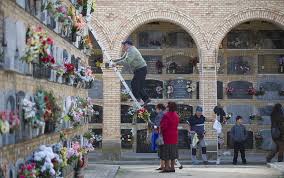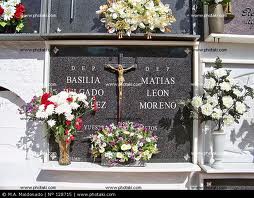When I was a child, Halloween didn’t exist in Spain. The festivity came from the U. S. much later, so that now, around October 30th, my nieces wear costumes to school, and learn how to say trick or treat (truco o trato) in English class. When I was their age, on Novermber 1st, el Día de Todos los Santos (All Saints Day) my parents and I would go al cementerio (to the cemetery) to “pay a visit” to our parientes difuntos (deceased relatives). I remember that I had to wear ropa de domingo (Sunday clothes) and that it was a day to estrenar (wear for the first time) some winter piece of clothing. My home town being Valencia, I remember that I used to be all itchy and sweaty with some new wool sweater that it was too early to wear.
 El Día de Todos los Santos was the only day of the year when many Spaniards visited el cementerio; that’s why the days before November 1st cemeteries were - and still are - very busy with women cleaning las tumbas (the tombs). Because Spain is a small country, the majority of the people are buried in nichos (niches), little houses stack upon one another.
El Día de Todos los Santos was the only day of the year when many Spaniards visited el cementerio; that’s why the days before November 1st cemeteries were - and still are - very busy with women cleaning las tumbas (the tombs). Because Spain is a small country, the majority of the people are buried in nichos (niches), little houses stack upon one another.

The nichos have lápidas, big granite plaques, with names, dates, and sometimes an inscription. November 1st is still a national holiday in Spain, and my mother and my aunts are already discussing whose turn it is this year to clean and put fresh flowers in las lápidas. When I was a child my grandparents were alive, and I found the tradition of going to the cemetery pretty annoying. Now, that my beloved grandparents are dead, I’d love to be in my home town and pay them a visit.